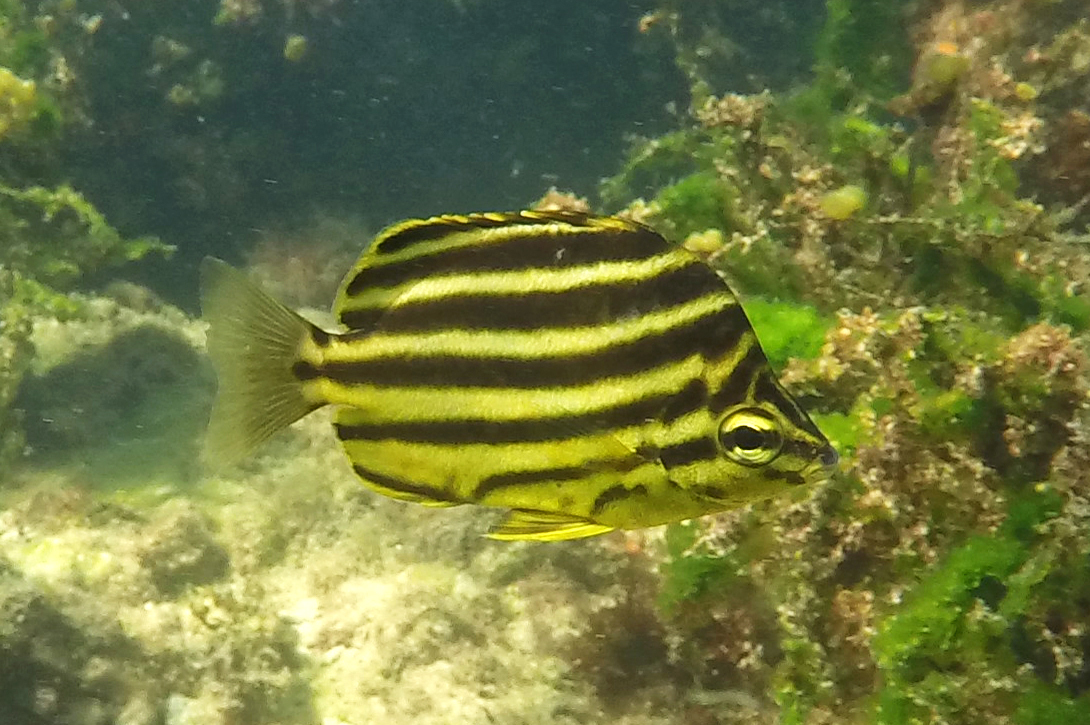Stripey, Microcanthus strigatus (Cuvier 1831)
Other Names: Eastern Stripey, Footballer, Western Stripey

A Stripey, Microcanthus strigatus, at the Omeo Wreck, Coogee, Western Australia, December 2018. Source: Ray Turnbull / iNaturalist.org. License: CC by Attribution-NonCommercial
Summary:
A bright yellow deep-bodied fish with a rounded dorsal profile, oblique black stripes along the side extending onto the dorsal and anal fins, and a black stripe from the forehead to just behind the eye. The fifth body stripe is inflected toward the anal fin origin at an angle of 120–150°, and the lower abdomen usually has a broken stripe, as a series of 2–5 spots and short dashes.
Cite this page as:
Bray, D.J. 2022, Microcanthus strigatus in Fishes of Australia, accessed 20 Apr 2024, https://fishesofaustralia.net.au/home/species/525
Stripey, Microcanthus strigatus (Cuvier 1831)
More Info
|
Distribution |
Cheynes Beach to Exmouth Gulf, Western Australia. Elsewhere, the species occurs in the Western-central Pacific: southern Japan, Korea, the eastern coast of China, Taiwan and Hong Kong, and Hawaii. Inhabits rocky and coral reefs in bays, harbours and coastal waters, sometimes forming large schools - commonly at depths of 10-30 m. Juveniles are often seen in tide pools, and adults often hang around jetty and wharf pylons. |
|
Features |
Dorsal fin XI,15–17; Anal fin III,13–15; Pectoral fin 15–17; Upper procurrent caudal-fin rays 8–9, lower procurrent caudal-fin rays 7–9; caudal fin total rays 32–35; Diagonal rows of scales in lateral series 48–57; Circumpeduncular scales 26–30; Gill rakers 16–17; branchiostegals 7. Body laterally compressed, moderately tall and roughly circular in lateral view, dorsal-fin origin to pelvic-fin origin 51.9–59.3% SL. |
|
Feeding |
Feeds on invertebrates and algae. |
|
Similar Species |
The East-Australian Stripey, Microcanthus joycae, differs in having a relatively straight fifth body stripe, without an inflection, and in lacking spots and short dashes on the breast and lower body. |
|
Etymology |
The specific name is from the Latin strigatus (= furrowed, grooved, strigate) in reference to the black stripes along the body. |
|
Species Citation |
Chaetodon strigatus Cuvier, in Cuvier & Valenciennes 1831, Histoire Naturelle des Poissons Vol. 7 25, pl. 170. Type locality: Japan. |
|
Author |
Bray, D.J. 2022 |
|
Resources |
Stripey, Microcanthus strigatus (Cuvier 1831)
References
Allen, G.R. 1997. Marine Fishes of Tropical Australia and South-east Asia. Western Australian Museum. 292 pp.
Allen, G.R. & R. Swainston. 1988. The Marine Fishes of North-Western Australia. A Field Guide for Anglers and Divers. Western Australian Museum. 201 pp.
Castelnau, F.L. de 1873. Contribution to the ichthyology of Australia. 8. Fishes of Western Australia. Proceedings of the Zoological and Acclimatisation Society of Victoria 2: 123-149 (as Neochaetodon vittatum)
Carpenter, K.E. 2001. Girellidae, Scorpididae, Microcanthidae. pp. 3297-3303 in Carpenter, K.E. & Niem, V.H. (eds). The Living Marine Resources of the Western Central Pacific. FAO Species Identification Guide for Fisheries Purposes. Rome : FAO Vol. 5 2791-3379 pp.
Carpenter, K.E. & Robertson, R. 2019. Microcanthus strigatus. The IUCN Red List of Threatened Species 2019: e.T68383670A68400634. https://dx.doi.org/10.2305/IUCN.UK.2019-2.RLTS.T68383670A68400634.en. Accessed on 10 March 2022.
Cuvier, G.L. in Cuvier, G.L. & Valenciennes, A. 1831. Histoire Naturelle des Poissons. Paris : Levrault Vol. 7 531 pp. pls 170-208. See ref at BHL
Hoschke, A., Whisson, G. & Moore, G.I. 2019. Complete list of fishes from Rottnest Island. pp. 150-161 in Whisson, G. & Hoschke, A. (eds). The Rottnest Island fish book. Perth : Aqua Research and Monitoring Services, 2nd edn.
Hutchins, J.B. 1994. A survey of the nearshore reef fish fauna of Western Australia's west and south coasts — The Leeuwin Province. Records of the Western Australian Museum, Supplement 46: 1-66 figs 1-6
Hutchins, J.B. 2001. Biodiversity of shallow reef fish assemblages in Western Australia using a rapid censusing technique. Records of the Western Australian Museum 20: 247-270
Hutchins, J.B. & Swainston, R. 1986. Sea Fishes of Southern Australia. Complete field guide for anglers and divers. Perth : Swainston Publishing 180 pp.
Hutchins, J.B. & Thompson, M. 1983. The Marine and Estuarine Fishes of South-western Australia. Perth : Western Australian Museum 103 pp. 345 figs.
Knudsen, S.W. & Clements, K.D. 2013. Revision of the family Kyphosidae (Teleostei: Perciformes). Zootaxa 3751(1): 1-101.
Knudsen, S.W. & Clements, K.D. 2016. World-wide species distributions in the family Kyphosidae (Teleostei: Perciformes). Molecular Phylogenetics and Evolution 101: 252-266. https://doi.org/10.1016/j.ympev.2016.04.037
Kuiter, R.H. 2002. Butterflyfishes, Bannerfishes and their Relatives. Chorleywood, U.K. : TMC Publishing 208 pp. (as Microcanthus vittatus)
Swainson, W. 1839. The natural history and classification of fishes, amphibians, and reptiles. In, Lardner, D. The Cabinet of Natural History. Vol. 2 London : Longman, Orme, Brown, Green & Longmans, and John Taylor 452 pp. 135 figs.
Tea, Y.K. & Gill, A.C. 2020. Systematic reappraisal of the anti-equatorial fish genus Microcanthus Swainson (Teleostei: Microcanthidae), with redescription and resurrection of Microcanthus joyceae Whitley. Zootaxa 4802(1): 41-60 https://doi.org/10.11646/zootaxa.4802.1.3
Tea, Y.‐K., Van Der Wal, C., Ludt, W.B., Gill, A.C., Lo, N. & Ho, S.Y.W. 2019. Boomeranging around Australia: Historical biogeography and population genomics of the anti‐equatorial fish Microcanthus strigatus (Teleostei: Microcanthidae). Molecular Ecology 2019; 15pp. https://doi.org/10.1111/mec.15172


